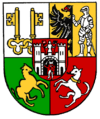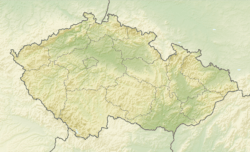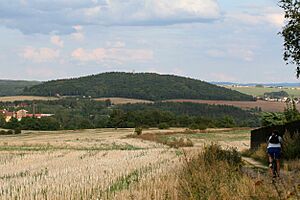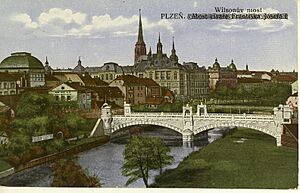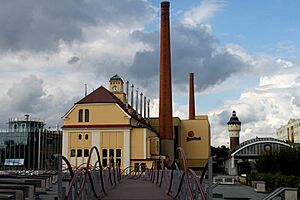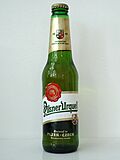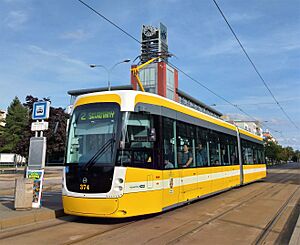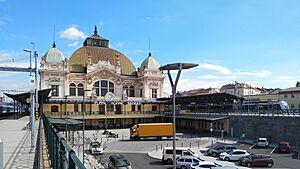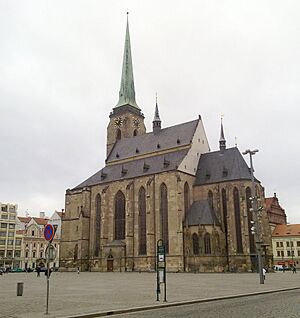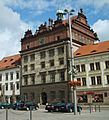Plzeň facts for kids
Quick facts for kids
Plzeň
Pilsen
|
|||||
|---|---|---|---|---|---|
|
Statutory city
|
|||||
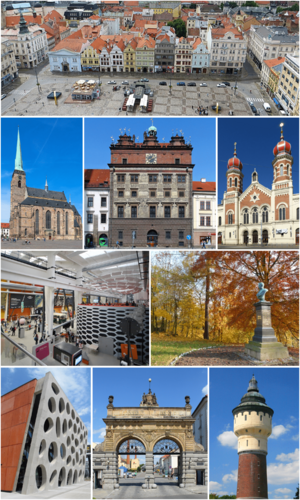
From top: Republic Square; Cathedral of St. Bartholomew; Renaissance City hall, Great Synagogue; Techmania Science Center; Lochotín park, New Theatre; Prazdroj brewery gate; and brewery water tower.
|
|||||
|
|||||
| Motto(s):
In hoc signo vinces
|
|||||
| Country | |||||
| Region | Plzeň | ||||
| District | Plzeň-City | ||||
| Founded | 1295 | ||||
| Area | |||||
| • Total | 137.65 km2 (53.15 sq mi) | ||||
| Elevation | 310 m (1,020 ft) | ||||
| Population
(2024-01-01)
|
|||||
| • Total | 185,599 | ||||
| • Density | 1,348.34/km2 (3,492.18/sq mi) | ||||
| Time zone | UTC+1 (CET) | ||||
| • Summer (DST) | UTC+2 (CEST) | ||||
| Postal codes |
301 00 – 326 00
|
||||
| Website | www.pilsen.eu | ||||
Plzeň (also known as Pilsen in English and German) is a city in the Czech Republic. It's located about 78 kilometers (48 miles) west of Prague in western Bohemia. Plzeň is the fourth largest city in the Czech Republic. It has about 186,000 people living there. If you include the surrounding urban area, the population is about 323,000.
Plzeň was founded as a royal city in the late 1200s. It quickly became an important town for trade. By the 1300s, it was the third largest city in Bohemia. In the 1800s, the city grew rapidly with new industries. The famous Škoda Works company started here. Plzeň is also known worldwide as the home of Pilsner beer. This beer was first made here in 1842. Today, the Pilsner Urquell Brewery is the biggest brewery in the Czech Republic.
Plzeň is the main business center for West Bohemia. It's also the capital of the Plzeň Region. The city is famous for its beautiful Baroque architecture. In 2015, Plzeň was even named a European Capital of Culture. The city is home to the successful football club FC Viktoria Plzeň and the ice hockey club HC Škoda Plzeň.
Contents
Exploring Plzeň's Geography
Plzeň is about 78 km (48 miles) west of Prague. Four rivers meet in the city: the Mže, Úhlava, Úslava, and Radbuza. After the Mže and Radbuza join, the river becomes known as the Berounka.
Most of Plzeň is in the Plasy Uplands. Some parts extend into the Švihov Highlands. The highest point in the city is Chlum hill, which is 416 meters (1,365 feet) above sea level. The lowest point is the Berounka river bed, at 293 meters (961 feet). The largest body of water is the České údolí Reservoir. There is also a system of ponds on the northern edge of the city.
Plzeň's Climate
Plzeň has a cool and mild Oceanic climate. This means it has moderate temperatures. The average rainfall each year is about 525 millimeters (20.7 inches). The average yearly temperature is 8.4°C (47.1°F). Temperatures have ranged from -28.0°C (-18.4°F) in winter to 40.1°C (104.2°F) in summer.
| Climate data for Plzeň-Bolevec, 1991–2020 normals, extremes 1969–present | |||||||||||||
|---|---|---|---|---|---|---|---|---|---|---|---|---|---|
| Month | Jan | Feb | Mar | Apr | May | Jun | Jul | Aug | Sep | Oct | Nov | Dec | Year |
| Record high °C (°F) | 16.8 (62.2) |
19.4 (66.9) |
24.7 (76.5) |
31.0 (87.8) |
33.7 (92.7) |
38.1 (100.6) |
40.1 (104.2) |
38.5 (101.3) |
34.9 (94.8) |
28.3 (82.9) |
19.2 (66.6) |
16.9 (62.4) |
40.1 (104.2) |
| Mean daily maximum °C (°F) | 2.4 (36.3) |
4.8 (40.6) |
9.8 (49.6) |
16.1 (61.0) |
20.6 (69.1) |
24.0 (75.2) |
26.1 (79.0) |
25.9 (78.6) |
20.3 (68.5) |
13.8 (56.8) |
6.9 (44.4) |
3.0 (37.4) |
14.5 (58.1) |
| Daily mean °C (°F) | −0.8 (30.6) |
−0.1 (31.8) |
3.4 (38.1) |
8.3 (46.9) |
13.2 (55.8) |
16.8 (62.2) |
18.4 (65.1) |
17.6 (63.7) |
12.6 (54.7) |
7.9 (46.2) |
3.4 (38.1) |
0.1 (32.2) |
8.4 (47.1) |
| Mean daily minimum °C (°F) | −4.1 (24.6) |
−4.2 (24.4) |
−1.4 (29.5) |
1.4 (34.5) |
6.0 (42.8) |
9.8 (49.6) |
11.5 (52.7) |
11.0 (51.8) |
7.0 (44.6) |
3.3 (37.9) |
0.2 (32.4) |
−2.8 (27.0) |
3.1 (37.6) |
| Record low °C (°F) | −27.2 (−17.0) |
−28.0 (−18.4) |
−27.6 (−17.7) |
−11.1 (12.0) |
−4.6 (23.7) |
−3.0 (26.6) |
1.4 (34.5) |
−0.9 (30.4) |
−3.5 (25.7) |
−10.8 (12.6) |
−17.0 (1.4) |
−27.9 (−18.2) |
−28.0 (−18.4) |
| Average precipitation mm (inches) | 28.1 (1.11) |
22.8 (0.90) |
30.9 (1.22) |
32.2 (1.27) |
56.9 (2.24) |
70.8 (2.79) |
72.0 (2.83) |
65.6 (2.58) |
43.4 (1.71) |
39.1 (1.54) |
32.3 (1.27) |
31.4 (1.24) |
525.4 (20.69) |
| Average snowfall cm (inches) | 15.2 (6.0) |
11.3 (4.4) |
4.6 (1.8) |
0.5 (0.2) |
0.0 (0.0) |
0.0 (0.0) |
0.0 (0.0) |
0.0 (0.0) |
0.0 (0.0) |
0.1 (0.0) |
3.1 (1.2) |
9.6 (3.8) |
44.5 (17.5) |
| Average relative humidity (%) | 84.9 | 80.7 | 77.0 | 71.8 | 71.1 | 71.6 | 72.1 | 74.5 | 80.1 | 84.2 | 88.0 | 87.3 | 78.6 |
| Mean monthly sunshine hours | 31.4 | 61.2 | 103.9 | 165.5 | 192.0 | 194.4 | 207.0 | 202.2 | 137.2 | 79.7 | 29.9 | 22.2 | 1,426.6 |
| Source: Czech Hydrometeorological Institute | |||||||||||||
A Look at Plzeň's History
Early Beginnings and Growth
The first mention of Plzeň Castle was in 976. The city of New Plzeň was founded in 1295 by King Wenceslaus II. The old settlement became known as Starý Plzenec. New Plzeň quickly became an important city for trade. It was on routes connecting Bohemia with places like Nuremberg and Regensburg.
By the 1300s, Plzeň had about 3,000 people. This made it the third largest city in Bohemia. The first record of beer brewing in Plzeň dates back to 1307.
Wars and Changes
During the Hussite Wars (in the 1400s), Plzeň was a strong center for Catholics. Prokop the Great, a Hussite leader, tried to capture it three times but failed. The city also joined a group of Catholic nobles against King George of Poděbrady.
In the 1470s and 1480s, Plzeň had the first printing press in Bohemia. The oldest book printed here was Statuta by Arnošt of Pardubice in 1476.
From 1599 to 1600, Emperor Rudolf II made Plzeň his home. During the Thirty Years' War (early 1600s), the city was taken by Peter Ernst, Count of Mansfeld in 1618. Imperial troops took it back in 1621. Later, Albrecht von Wallenstein used it as his winter base in 1633. The city's defenses were strengthened from 1645 to 1649.
Since the late 1600s, Plzeň's buildings have been influenced by the Baroque style. The city center has been protected as a cultural heritage site since 1989.
Industrial Revolution and Modern Times
In the second half of the 1800s, Plzeň grew very fast with industries. In 1869, Emil Škoda started the Škoda Works company. This became a very important engineering company. It supplied arms to the Austro-Hungarian Army. By 1917, Škoda Works had over 30,000 workers.
After 1898, the National Railways train workshop was the second largest employer. It had about 2,000 workers. Between 1861 and 1877, the Plzeň railway system was completed. In 1899, the first tram line started in the city. This industrial growth led to more Czech people living in the city. After 1868, the first Czech mayor was elected.
World War II and After
After Czechoslovakia became independent in 1918, some German-speaking people near Plzeň wanted to join Austria. After 1933, some supported the Nazis. They hoped to be united with Germany.
After the Munich Agreement in 1938, Plzeň became a border town. Nazi Germany's borders moved closer. During the German occupation from 1939 to 1945, the Škoda Works had to make weapons for the German army. The Nazis also ran a prison and a camp where people were forced to work.
Between January 17 and 26, 1942, most of the city's Jewish population, over 2,000 people, were sent to the Theresienstadt concentration camp.
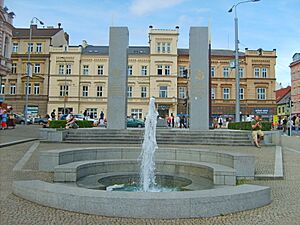
On May 6, 1945, near the end of World War II in Europe, Plzeň was freed from Nazi Germany. The 16th Armored Division of General George Patton's 3rd Army liberated the city. Other parts of Czechoslovakia were freed by the Soviet Red Army. After the war, the German-speaking people in Plzeň were moved out of the city.
Communist Era and Uprising
After the 1948 Czechoslovak coup d'état (when the Communist party took control), the government changed money rules in 1953. This made many people unhappy. On June 1, 1953, over 20,000 people protested. Many were workers from the Škoda Works. They went into the town hall and threw out communist symbols. The government responded strongly. They destroyed a statue of Tomáš Garrigue Masaryk, the first president of Czechoslovakia. The statue has since been put back up.
In 1954, a homing pigeon from West Germany got lost near the border. It returned two days later with an anti-communist message. The bird, named Leaping Lena, became a symbol of the Cold War.
Plzeň's Economy and Industry
Plzeň is a major business center in the western Czech Republic. Since the late 1990s, many foreign companies have invested in the city. For example, in 2007, a large shopping mall and entertainment center called Pilsen Plaza opened.
Plzeň produces about two-thirds of the Plzeň Region's total economic output. This makes it one of the most successful cities in the Czech Republic.
The Škoda Works company, started in Plzeň in 1859, was very important for engineering. During the Communist era (1948–1989), the company made products for the Eastern Bloc countries. After the Velvet Revolution in 1989, the company faced challenges. It was later divided into several smaller companies. Important ones today are Škoda Transportation and Doosan Škoda Power.
Many international companies now have factories in Plzeň. These include Daikin, Hisense, and Panasonic. The software company ZF Openmatics also started here. Fernet Stock, located in the Božkov area, is the largest distillery in the Czech Republic.
The Story of Pilsner Beer
Plzeň is famous for its breweries, especially Pilsner Urquell (since 1842) and Gambrinus (since 1869). These are now owned by Asahi Group Holdings.
Plzeň is very important in the history of beer, especially for developing the Pilsner style. In 1375, King Charles IV gave the Dobrow Monastery near Plzeň the right to brew beer. Many breweries were located in the city's deep cellars.
In 1839, officials in Plzeň started a city-owned brewery. It was called Bürger Brauerei (Citizens' Brewery), now Plzeňský Prazdroj. They hired a Bavarian brewer named Josef Groll. On October 5, 1842, he made the first batch of modern Pilsner beer. This beer was clear and golden. It was made using pale malts, Plzeň's soft water, and Saaz hops. This new beer quickly became popular across Central Europe.
In 1859, "Pilsner Bier" was officially registered as a brand name. In 1898, the Pilsner Urquell trademark was created. This showed that it was the original brewery where the Pilsner style began.
Getting Around Plzeň
Public Transport
Plzeň has a great public transport system. It includes trams, trolleybuses, and buses. These are run by the PMDP company. You can buy tickets from machines or small shops. These tickets work for any city transport. If you live in Plzeň, you can get a "Plzeň Card." You can add money to it and use it for unlimited public transport. You can also buy tickets on vehicles using a contactless smart card.
Trains
Plzeň is a key center for train travel in the Czech Republic. Five main railway lines cross here:
- Line Nr. 170: Prague – Beroun – Plzeň – Cheb
- Line Nr. 180: Plzeň – Domažlice – Furth im Wald (Germany)
- Line Nr. 183: Plzeň – Klatovy – Železná Ruda
- Line Nr. 160: Plzeň – Žatec
- Line Nr. 190: Plzeň – České Budějovice
All these lines use the Plzeň main railway station.
Roads and Air Travel
The most important road is the D5 highway. It connects Prague and Nuremberg. There is also a public airport 11 km (7 miles) southwest of Plzeň. It's near the village of Líně.
Education in Plzeň
The University of West Bohemia in Plzeň is well known. Its Faculty of Law, Faculty of Mechanical Engineering, and Faculty of Applied Science are especially famous.
Martin Luther Elementary School (Základní škola Martina Luthera) is a private Christian school in Plzeň.
Culture and Sports
Plzeň was a European Capital of Culture in 2015. It shared this honor with Mons in Belgium.
The ice hockey team HC Škoda Plzeň plays in the Czech Extraliga. They play their home games at Home Monitoring Aréna. The football club FC Viktoria Plzeň plays in the Czech First League. They are one of the most successful clubs in the Czech Republic. Viktoria Plzeň has even played in the UEFA Champions League and UEFA Europa League. Their home games are at Doosan Arena.
The handball club Talent Plzeň plays in the Czech Handball Extraliga. The motorcycle speedway team PK Plzeň races at the Plzeň speedway track. This track has hosted important speedway events.
Places to See in Plzeň
Some of the most famous sights in Plzeň are:
- The Gothic St. Bartholomew's Cathedral. It was founded in the late 1200s. Its tower is 102 meters (335 feet) high, making it the tallest in the Czech Republic.
- The Renaissance Town Hall.
- The Moorish Revival Great Synagogue. It's the second largest synagogue in Europe, after the one in Budapest.
- A 20 km (12 miles) network of historic tunnels and cellars. This is one of the longest in Central Europe. You can take tours of about 750 meters (2,460 feet) of it, going down to 12 meters (39 feet) deep.
The old water tower, built in 1532, was part of the city's defenses. Another level was added in 1822. A Gothic entrance from the 1500s was added in 1912. Above it, there's a plaque for Dr. Joseph Škoda, who was born nearby in 1805.
A popular activity for visitors is the Plzeňský Prazdroj brewery tour. Here, you can learn about the history of beer.
Museums to Visit
- Franciscan Monastery – This is a Museum of Christian Art.
- Západočeské muzeum v Plzni – This is the Museum of Western Bohemia.
Famous People from Plzeň
- Emil von Škoda (1839–1900), engineer who founded Škoda Works
- František Křižík (1847–1941), inventor
- Josef Skupa (1892–1957), famous puppeteer
- Jiří Trnka (1912–1969), artist
- Miroslav Štandera (1918–2014), fighter pilot in World War II
- Ota Šik (1919–2004), economist
- Karel Gott (1939–2019), very popular singer
- Peter Grünberg (1939–2018), German physicist and Nobel Prize winner
- Petr Čech (born 1982), famous football player
- Kateřina Emmons (born 1983), Olympic medalist in sport shooting
- Barbora Strýcová (born 1986), tennis player
Plzeň's Sister Cities
Plzeň is twinned with these cities around the world:
 Birmingham, United States
Birmingham, United States Liège, Belgium
Liège, Belgium Limoges, France
Limoges, France Regensburg, Germany
Regensburg, Germany Takasaki, Japan
Takasaki, Japan Winterthur, Switzerland
Winterthur, Switzerland Žilina, Slovakia
Žilina, Slovakia
Images for kids
See also
 In Spanish: Pilsen para niños
In Spanish: Pilsen para niños



